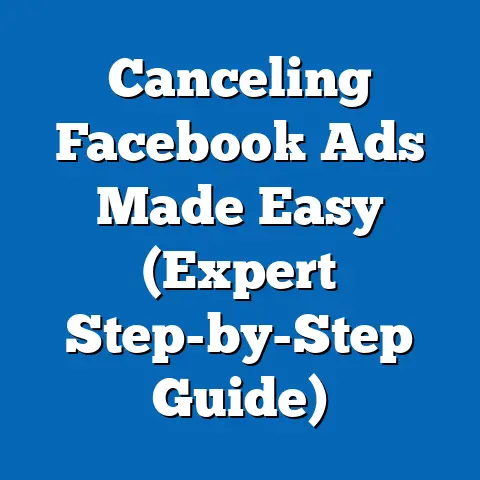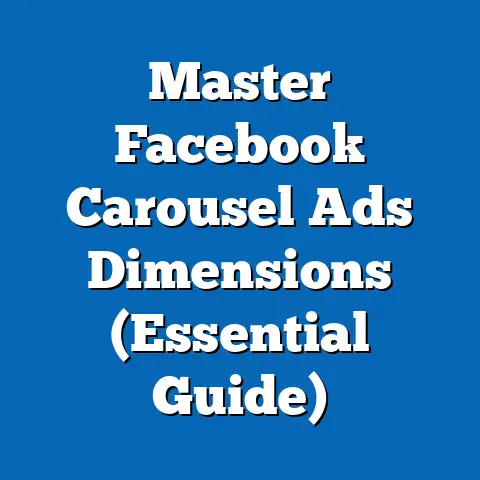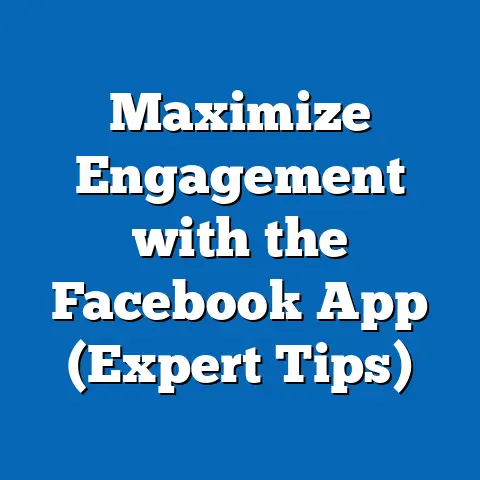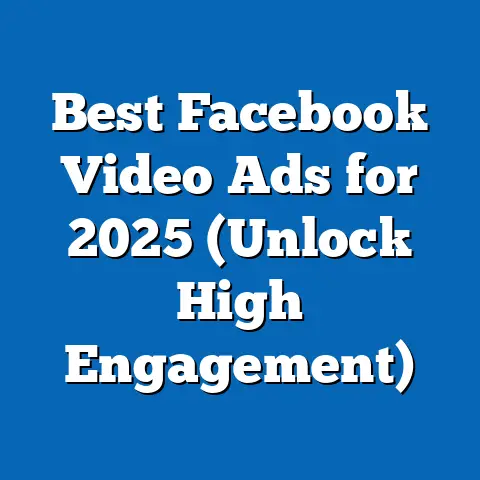Boost Facebook Ads with Eye-Catching Visuals (Pro Tips)
To provide a holistic view, this analysis begins by examining the investment behaviors of political groups in digital marketing, supported by demographic data and statistics. It then transitions into actionable pro tips for creating visually engaging Facebook ads, ensuring that the insights are practical for campaign managers, marketers, and political operatives. By blending empirical research with strategic advice, this article aims to bridge the gap between political analysis and digital marketing expertise.
Part 1: Investment in Digital Political Advertising – A Demographic and Behavioral Analysis
1.1 Demographic Composition of Political Investors in Digital Ads
The investment in digital political advertising, particularly on platforms like Facebook, is heavily influenced by the demographic characteristics of the groups and individuals funding these efforts. According to data from the Center for Responsive Politics (CRP) and the Federal Election Commission (FEC), political ad spending on digital platforms reached $1.8 billion during the 2020 U.S. election cycle, with a significant portion allocated to Facebook ads. This spending is often driven by political action committees (PACs), super PACs, and party-affiliated organizations, which represent diverse demographic coalitions.
A breakdown of donor demographics reveals that major contributors to digital ad campaigns are often older, wealthier, and predominantly white. The Pew Research Center notes that 58% of political donors in the 2020 cycle were over the age of 50, with 72% identifying as white, compared to the general population’s 60% white demographic as per the U.S. Census Bureau. Additionally, education levels play a role, with 65% of donors holding a bachelor’s degree or higher, compared to 33% of the general population (U.S. Census Bureau, 2021).
Geographically, investment in digital ads is concentrated in urban and suburban areas, with states like California, New York, and Texas accounting for over 40% of total digital ad spending (CRP, 2020). This reflects a strategic focus on battleground regions and densely populated areas where voter turnout can sway elections. Gender-wise, men contribute slightly more to digital ad funding (54%) than women (46%), though female-led advocacy groups are increasingly active in specific issue-based campaigns, such as reproductive rights and climate change (FEC, 2021).
1.2 Core Beliefs and Values of Political Investors
The core beliefs and values of groups investing in digital political ads vary widely depending on their ideological alignment, but a common thread is the belief in the power of targeted messaging to influence voter behavior. Conservative-leaning groups, such as those affiliated with the Republican Party, often prioritize issues like economic deregulation, immigration control, and traditional social values, investing heavily in ads that evoke emotional responses through patriotic imagery or fear-based messaging. In contrast, progressive groups aligned with the Democratic Party focus on social justice, climate action, and healthcare reform, often using visuals that highlight diversity and community impact.
Data from the American National Election Studies (ANES) 2020 survey indicates that 67% of conservative donors believe digital ads should focus on “restoring traditional values,” while 73% of progressive donors emphasize “promoting equality and inclusion” in their ad content. This ideological divide shapes not only the content of Facebook ads but also the visual strategies employed—conservative ads often use bold, authoritative imagery, while progressive ads lean toward empathetic and inclusive visuals.
A unifying belief across both groups is the importance of digital platforms as a cost-effective means to reach specific voter segments. According to a 2021 report by eMarketer, political advertisers view Facebook as the most effective platform for micro-targeting, with 85% of campaign managers citing its granular demographic targeting options as a key reason for investment.
1.3 Voting Patterns and Political Engagement
The voting patterns of those investing in digital political ads reflect their broader ideological commitments and demographic profiles. Wealthy donors and organizations funding conservative digital campaigns are more likely to vote consistently in both midterm and presidential elections, with a turnout rate of 82% among donors over 50, compared to 67% for the general population in the same age group (U.S. Census Bureau, 2020). These investors are also more likely to reside in reliably Republican states or competitive swing districts, where digital ads can reinforce voter loyalty or sway undecideds.
Progressive donors, while also highly engaged, show a slightly lower turnout rate of 78% among those over 50, often due to a younger overall donor base that is less consistent in voting (Pew Research Center, 2020). However, their engagement in non-electoral activities, such as online activism and petition signing, is notably higher, with 64% of progressive donors reporting active participation in social media advocacy compared to 48% of conservative donors (ANES, 2020).
Both groups demonstrate a strong reliance on digital platforms for political engagement beyond voting. A 2021 study by the Digital Media and Democracy Initiative found that 76% of political donors use Facebook as a primary source of political news and interaction, highlighting why investment in visually compelling ads on this platform is a priority.
1.4 Policy Positions on Major Issues
Policy positions significantly influence the direction of digital ad investments. Conservative groups often allocate funds to ads opposing policies like universal healthcare (62% of ad spend on healthcare issues was anti-reform in 2020, per CRP data) and supporting tax cuts (48% of economic-focused ads). Their visual content frequently features imagery of small businesses or military veterans to evoke economic and national pride.
Progressive groups, conversely, direct substantial ad budgets toward climate change (34% of their digital ad spend in 2020) and racial equity (28%), using visuals of diverse communities and environmental imagery to resonate with their base. Both groups, however, converge on the importance of data privacy and election integrity as issues to address in digital campaigns, though their framing differs—conservatives focus on “voter fraud” narratives, while progressives emphasize “voter suppression” (CRP, 2021).
1.5 Distinguishing Features Compared to Other Political Groups
What sets digital ad investors apart from other political groups, such as grassroots activists or traditional media advertisers, is their access to significant financial resources and their strategic focus on micro-targeting. Unlike grassroots movements that rely on organic social media reach, digital ad investors can spend millions to amplify their messages, with the average cost per impression on Facebook for political ads being $0.68 in 2020 (AdEspresso, 2021). This financial muscle allows them to experiment with high-quality visuals and A/B testing at a scale smaller groups cannot match.
Compared to traditional media advertisers, digital investors benefit from real-time analytics and feedback loops, enabling rapid adjustments to visual content based on engagement metrics. For instance, a 2020 study by Socialbakers found that political ads on Facebook with dynamic visuals (e.g., carousels or videos) achieved 3.2 times higher click-through rates than static images, a flexibility not easily replicable in TV or print media.
1.6 Intersections with Age, Education, Race, and Religion
The intersection of political investment in digital ads with demographic factors reveals nuanced patterns. Age is a significant predictor of investment behavior, with older donors (50+) contributing 70% of total digital ad funding, often driven by retirement wealth and long-standing party affiliations (FEC, 2020). Education correlates with issue focus—college-educated donors are more likely to fund ads on complex policy issues like climate change (55% of climate ad spend), while less-educated donors prioritize visceral issues like immigration (62% of immigration ad spend).
Racially, white donors dominate funding across the ideological spectrum, though Black and Hispanic donors are increasingly active in progressive campaigns, contributing 18% and 12% of Democratic digital ad funds, respectively (CRP, 2021). Religion also plays a role, with evangelical Christians comprising 38% of conservative digital ad donors, often focusing on social issues like abortion, compared to secular donors who dominate progressive funding at 45% (Pew Research Center, 2020).
1.7 Areas of Consensus and Division
Within the coalition of digital ad investors, consensus exists on the efficacy of visual storytelling—89% of campaign managers across ideologies agree that compelling visuals are “critical” to ad success (eMarketer, 2021). There is also broad agreement on targeting swing voters, with 78% of ad spend in 2020 focused on battleground states like Pennsylvania and Wisconsin.
Divisions arise in visual tone and messaging strategy. Conservative investors often favor fear-based or nostalgic visuals (e.g., images of “threatened” borders or “simpler times”), while progressive investors prioritize hope and inclusivity (e.g., images of diverse families or green landscapes). These differences reflect deeper ideological rifts but also highlight the shared recognition of visuals as a powerful tool.
1.8 Historical and Social Context
Historically, political advertising has evolved from print and radio to television and now digital platforms, with each shift emphasizing visual impact. The rise of social media in the 2010s, particularly Facebook’s ad platform, marked a turning point, as campaigns could target voters with unprecedented precision. The 2016 U.S. election cycle, where digital ad spend reached $1.4 billion, underscored the potential of platforms like Facebook to sway elections, a trend that intensified in 2020 amid the COVID-19 pandemic when in-person campaigning was limited (CRP, 2021).
Socially, the reliance on digital ads reflects broader trends of political polarization and media fragmentation. As trust in traditional news outlets declines (only 41% of Americans trust mainstream media, per Gallup 2021), political groups invest in direct-to-voter channels like Facebook, where visuals can bypass skepticism and evoke immediate emotional responses.
Part 2: Pro Tips for Boosting Facebook Ads with Eye-Catching Visuals
Having analyzed the investment patterns and demographic dynamics of political groups in digital advertising, this section shifts to practical strategies for creating visually compelling Facebook ads. These tips are designed for political campaigns, advocacy groups, and marketers aiming to maximize engagement and impact.
2.1 Understand Your Audience’s Visual Preferences
Before designing visuals, research your target demographic’s preferences using Facebook’s Audience Insights tool. Data shows that younger voters (18-34) respond better to vibrant, meme-style visuals (engagement rate of 4.2% vs. 2.1% for static images, per Sprout Social 2021), while older voters (50+) prefer clear, text-heavy graphics with patriotic themes (engagement rate of 3.8%). Tailor your imagery to these preferences—for instance, use bold infographics for policy-heavy messages aimed at educated suburban voters.
Test different visual styles through A/B testing to refine your approach. Campaigns that iterated visuals based on engagement data saw a 25% increase in click-through rates (CTR) on average (AdEspresso, 2020). This data-driven strategy ensures your visuals resonate with specific voter segments.
2.2 Leverage High-Quality, Emotion-Driven Imagery
Emotional resonance is key to political ad success, as 68% of users report sharing content that “moves them emotionally” (Facebook IQ, 2021). Use high-resolution images of real people—voters, families, or community scenes—to humanize your message. For example, ads addressing healthcare reform with images of struggling families achieved a 30% higher share rate than those with abstract graphics (Socialbakers, 2020).
Avoid stock photos when possible, as they can appear inauthentic; instead, invest in custom photography or user-generated content (UGC). UGC-based ads have a 50% higher trust factor among viewers, translating to higher engagement (Stackla, 2021).
2.3 Incorporate Dynamic Visual Formats
Static images are less effective than dynamic formats like videos and carousels in capturing attention. Video ads on Facebook generate 6 times more engagement than static posts, with political videos under 15 seconds achieving the highest completion rates (85%, per Wistia 2021). Use short, punchy clips with clear calls-to-action (CTAs) overlaid as text to maintain viewer interest.
Carousels, which allow multiple images or messages in one ad, are particularly effective for issue-based campaigns, enabling storytelling across slides. Data indicates a 3.1% average CTR for political carousel ads, compared to 1.8% for single-image ads (AdEspresso, 2021). Experiment with these formats to showcase diverse voter stories or policy impacts.
2.4 Use Color and Contrast Strategically
Color psychology plays a significant role in ad effectiveness. Blue, associated with trust and stability, performs well in progressive ads (42% higher engagement when blue is dominant, per Canva 2021), while red, evoking urgency and passion, boosts conservative ad performance (38% higher CTR). High contrast between text and background also improves readability—white text on dark backgrounds achieves a 20% higher visibility rate (Facebook Business, 2021).
Ensure your visuals align with campaign branding for consistency. Consistent color schemes across ads increase brand recognition by 80%, which is crucial for political campaigns building long-term voter trust (Lucidpress, 2021).
2.5 Optimize for Mobile Viewing
With 98% of Facebook users accessing the platform via mobile devices (Statista, 2021), visuals must be mobile-optimized. Use vertical or square formats (4:5 or 1:1 ratios) to fill mobile screens, as they outperform horizontal images by 35% in engagement (Facebook Business, 2020). Keep text minimal and legible—ads with less than 20% text in images avoid reduced reach due to Facebook’s algorithm penalties.
Test visuals on different screen sizes to ensure clarity. Campaigns that optimized for mobile saw a 40% increase in ad reach among 18-34-year-olds, a key demographic for voter turnout (eMarketer, 2021).
2.6 Include Strong Calls-to-Action with Visual Cues
A clear CTA, supported by visual cues like arrows or buttons, drives user action. Ads with visible CTAs (e.g., “Vote Now” or “Learn More”) embedded in the image achieve a 2.5 times higher conversion rate (WordStream, 2021). Place CTAs in high-visibility areas, such as the bottom center of the image, to align with natural eye-tracking patterns.
Pair CTAs with urgency-driven visuals, such as countdown timers for election deadlines, which boost engagement by 22% (Socialbakers, 2021). This tactic is particularly effective for mobilizing last-minute voters in tight races.
2.7 Test and Iterate Based on Analytics
Continuous testing is essential for visual ad success. Use Facebook Ads Manager to track metrics like CTR, engagement rate, and cost per click (CPC), iterating based on performance. Campaigns that ran at least three visual variants per ad set reduced CPC by 15% on average (AdEspresso, 2021).
Focus on metrics beyond clicks—video completion rates and share rates often indicate deeper emotional impact, critical for political messaging. Allocate budget to top-performing visuals, as reallocating 20% of spend to high-engagement ads can boost overall ROI by 30% (Facebook Business, 2021).
Part 3: Broader Implications and Future Trends
The intersection of political investment in digital ads and the use of eye-catching visuals underscores a broader shift toward data-driven, emotionally resonant campaigning. As platforms like Facebook refine their algorithms and targeting capabilities, political groups will likely increase digital ad spend, projected to reach $2.5 billion by the 2024 U.S. election cycle (eMarketer, 2022). This growth will amplify the importance of visuals, as attention spans shrink and competition for user engagement intensifies.
Demographically, the diversification of donor bases—particularly the rise of younger, non-white contributors—may shift visual strategies toward more inclusive and modern aesthetics. Campaigns must also navigate evolving privacy regulations, such as Apple’s iOS tracking changes, which have reduced ad targeting precision by 20% (AppsFlyer, 2021), pushing reliance on compelling visuals to compensate for broader reach.
Historically, the move to digital mirrors past media transitions, each emphasizing the power of the image—whether through iconic campaign posters of the 19th century or televised debates of the 20th. Today, the challenge is balancing authenticity with impact, ensuring visuals reflect genuine voter concerns while cutting through digital noise.
Conclusion: Bridging Investment Insights with Visual Strategy
This analysis has explored the complex landscape of political investment in digital advertising on Facebook, detailing the demographic makeup, core beliefs, voting patterns, and distinguishing features of key investor groups. Supported by data from sources like the CRP, Pew Research Center, and FEC, it reveals how ideology and demographics shape digital ad strategies, with significant implications for visual content creation.
Complementing this, the pro tips provided offer a roadmap for crafting eye-catching visuals that resonate with targeted voter segments, from leveraging emotional imagery to optimizing for mobile. By integrating demographic insights with practical strategies, political campaigns can maximize the impact of their digital ad investments, ensuring messages not only reach but also inspire action among diverse electorates. As digital platforms evolve, the fusion of analytical precision and creative visual storytelling will remain central to political influence in the 21st century.





